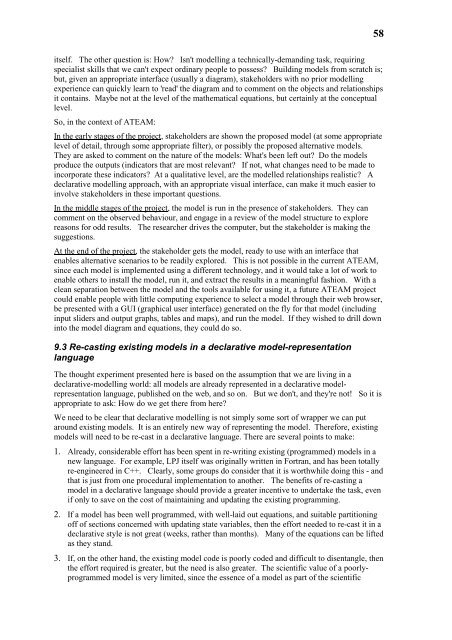pdf: 600KB - Potsdam Institute for Climate Impact Research
pdf: 600KB - Potsdam Institute for Climate Impact Research
pdf: 600KB - Potsdam Institute for Climate Impact Research
Create successful ePaper yourself
Turn your PDF publications into a flip-book with our unique Google optimized e-Paper software.
58<br />
itself. The other question is: How? Isn't modelling a technically-demanding task, requiring<br />
specialist skills that we can't expect ordinary people to possess? Building models from scratch is;<br />
but, given an appropriate interface (usually a diagram), stakeholders with no prior modelling<br />
experience can quickly learn to 'read' the diagram and to comment on the objects and relationships<br />
it contains. Maybe not at the level of the mathematical equations, but certainly at the conceptual<br />
level.<br />
So, in the context of ATEAM:<br />
In the early stages of the project, stakeholders are shown the proposed model (at some appropriate<br />
level of detail, through some appropriate filter), or possibly the proposed alternative models.<br />
They are asked to comment on the nature of the models: What's been left out? Do the models<br />
produce the outputs (indicators that are most relevant? If not, what changes need to be made to<br />
incorporate these indicators? At a qualitative level, are the modelled relationships realistic? A<br />
declarative modelling approach, with an appropriate visual interface, can make it much easier to<br />
involve stakeholders in these important questions.<br />
In the middle stages of the project, the model is run in the presence of stakeholders. They can<br />
comment on the observed behaviour, and engage in a review of the model structure to explore<br />
reasons <strong>for</strong> odd results. The researcher drives the computer, but the stakeholder is making the<br />
suggestions.<br />
At the end of the project, the stakeholder gets the model, ready to use with an interface that<br />
enables alternative scenarios to be readily explored. This is not possible in the current ATEAM,<br />
since each model is implemented using a different technology, and it would take a lot of work to<br />
enable others to install the model, run it, and extract the results in a meaningful fashion. With a<br />
clean separation between the model and the tools available <strong>for</strong> using it, a future ATEAM project<br />
could enable people with little computing experience to select a model through their web browser,<br />
be presented with a GUI (graphical user interface) generated on the fly <strong>for</strong> that model (including<br />
input sliders and output graphs, tables and maps), and run the model. If they wished to drill down<br />
into the model diagram and equations, they could do so.<br />
9.3 Re-casting existing models in a declarative model-representation<br />
language<br />
The thought experiment presented here is based on the assumption that we are living in a<br />
declarative-modelling world: all models are already represented in a declarative modelrepresentation<br />
language, published on the web, and so on. But we don't, and they're not! So it is<br />
appropriate to ask: How do we get there from here?<br />
We need to be clear that declarative modelling is not simply some sort of wrapper we can put<br />
around existing models. It is an entirely new way of representing the model. There<strong>for</strong>e, existing<br />
models will need to be re-cast in a declarative language. There are several points to make:<br />
1. Already, considerable ef<strong>for</strong>t has been spent in re-writing existing (programmed) models in a<br />
new language. For example, LPJ itself was originally written in Fortran, and has been totally<br />
re-engineered in C++. Clearly, some groups do consider that it is worthwhile doing this - and<br />
that is just from one procedural implementation to another. The benefits of re-casting a<br />
model in a declarative language should provide a greater incentive to undertake the task, even<br />
if only to save on the cost of maintaining and updating the existing programming.<br />
2. If a model has been well programmed, with well-laid out equations, and suitable partitioning<br />
off of sections concerned with updating state variables, then the ef<strong>for</strong>t needed to re-cast it in a<br />
declarative style is not great (weeks, rather than months). Many of the equations can be lifted<br />
as they stand.<br />
3. If, on the other hand, the existing model code is poorly coded and difficult to disentangle, then<br />
the ef<strong>for</strong>t required is greater, but the need is also greater. The scientific value of a poorlyprogrammed<br />
model is very limited, since the essence of a model as part of the scientific
















